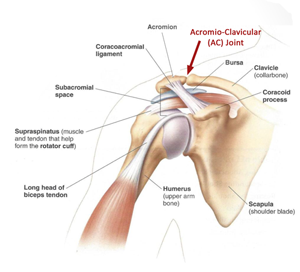Shoulder Bursitis/Impingement
What is shoulder impingement/bursitis?

The shoulder is a very complicated joint that involves three bones that are all very mobile. There are numerous muscles involved: some muscles control the movements between those three bones so that the other, bigger muscles can produce powerful shoulder and arm actions. The rotator cuff is a group of muscles that control movement between the arm and the shoulder blade. Unfortunately, part of the rotator cuff has to travel back and forth within a tight space. If there is anything that inflames, strains or irritates the tendon, causes swelling in that space or narrows that space, “impingement” can occur. This is when the tendon gets ‘pinched’ in the ‘subacromial space’. Usually there is pain that only occurs in certain positions and movements.
What is the difference between impingement / bursitis / swimmer’s shoulder / tendonitis?
Technically those terms can be slightly different things but they are all used to describe catching or irritation occurring inside the subacromial space. The bursa is just a little sack of protective fluid that can become inflamed and enlarged. People with this condition may have also been told you have a rotator cuff problem or irritation of your supraspinatus tendon
How is shoulder impingement / bursitis diagnosed?
Often shoulder impingement bursitis is a ‘clinical diagnosis’ which means an expert clinician can make the diagnosis with clinical tests and without the need for any type of scan. We need to be careful about ultrasound findings in the condition because bursa thickening is a very subjective finding that can also be a normal adaptation. Just because an ultrasound report says you’ve got bursitis, it does not necessarily confirm that as the cause of your pain. If your doctor is concerned that the diagnosis is unclear or that there may be something like a bone spur contributing to the problem they may order additional tests.
What is the treatment for shoulder impingement?
Treatment usually depends on the cause. If there is a problem with the way you move or train we can help you identify it and will work with your physiotherapist to fix it. One of the main issues with this problem is excessive inflammation in the subacromial space creates further impingement and further inflammation. This cycle can usually be successfully resolved with reducing the inflammation – either with oral medications or with an ultrasound guided corticosteroid injection. If the diagnosis is correct an injection is usually extremely effective in settling things down but often the underlying cause needs to be identified to be certain that it won’t return.
What if I don’t get better with an injection?
There can be many reasons for this. The most common reason is that the wrong diagnosis may have been made. Not every swimmer with a sore shoulder has “swimmer’s shoulder”. It is extremely common for AC joint pain to behave in a similar way. See this article here. Another reason may be a structural cause to your impingement/bursitis such as a bone spur, calcification of your tendon or a higher-grade tendon tear. In these situations, impingement pain can temporarily settle with an injection only to recur.






















